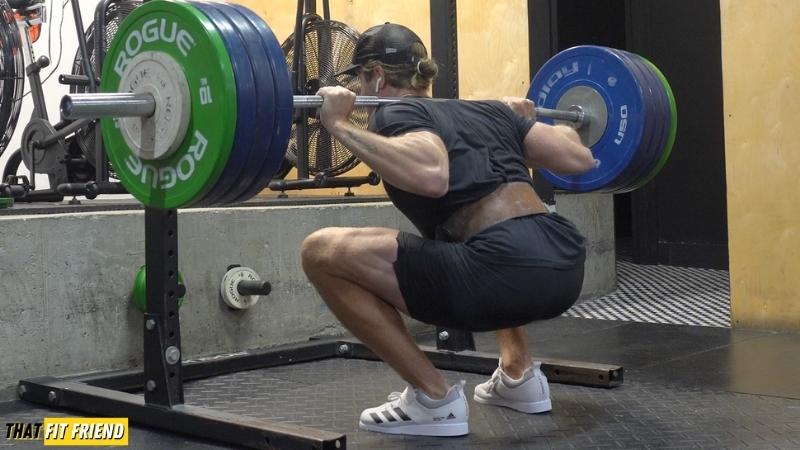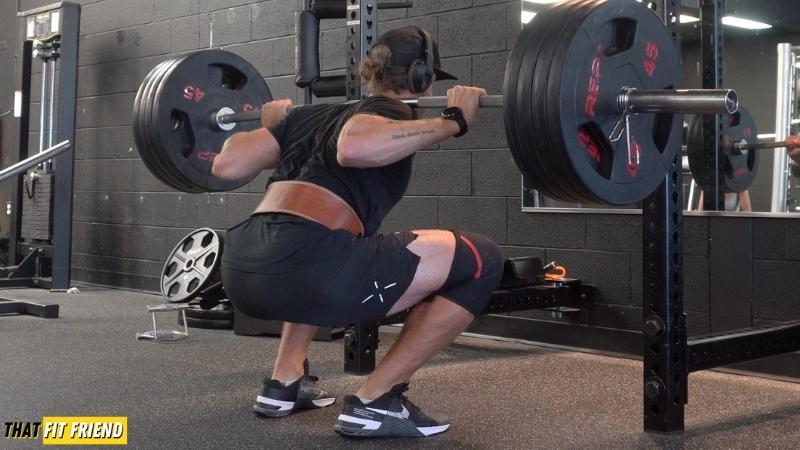As a basic rule of thumb when it comes to squat and deadlift order, I typically suggest that most lifters pick and perform the exercise that they struggle most with first. This way you can invest your fresh energy into the “tougher” exercise for you.
Should you squat or deadlift first? This is a fun programming question that reminds me of the age-old debate, “Did the chicken come before the egg?”
The topic of squatting before or after deadlifting is a question that requires context and nuance. For example, it isn’t always a straightforward equation of, “You should always squat before you deadlift.”
Which Exercise Feels Tougher for You?
The first way that I like to approach the topic of squatting or deadlifting first is to explore the topic of which exercise requires more effort from you individually.
The squat and deadlift are both very skill and they require high degrees of mental focus along with physical effort. Generally speaking, every lifter will find that one of these exercises tends to “click” more than its peer.
For example, the deadlift is an exercise that feels second nature to me, but my back squat requires a lot more preparation, thought, effort, and total energy.
If you’re trying to make steady improvements on both exercises simultaneously, then in this context, you’ll perform the exercise that you struggle with most first. This allows us to give the most energy possible to the movement that is tougher.
So for me, I would squat before I deadlift because I want to sink a lot of effort and focus into that exercise, and my deadlift is easier for me so it requires a lot less thought when executing reps.
- Exercise 1 Tougher Exercise: Squat | 4 x 6 @ Ascending load from 3-4 RIR to 2-3 RIR
- Exercise 2 “Easier” Exercise: Deadlift | 4 x 2 @ 1-2 RIR
To play devil’s advocate with me, let’s say the movement you’re better at is your higher effort exercise for the day. Should you still perform that movement second?
For recreational lifters, my answer would be, yes. More than likely you want to bring up your lagging lift, so even if, your better lift is the higher intensity movement for the day it can still pay off programming the more difficult exercise first.
I find that most lifters lose mental focus first in workouts and if they’re automatic with one of these lifts, then I’m not typically too concerned about the execution of their stronger lift even if it’s coming second.
Which Exercise Is Your “Main” Focus?
Another way to approach the topic of structuring squats and deadlifts on the same day is to look at this question from a “focus” lens. This context will typically only apply to lifters who are very proficient in both lifts.
If your squat and deadlift abilities are relatively equal, structuring them in a way that emphasizes one over the other regarding the intensities you’re using can be a good programming method.
For example, let’s say you’re in a deadlift-focused block. For six weeks, you’ll hammer the deadlift with higher intensities while working to maintain and slowly build on your squat.
In this example, it would make the most sense to program your deadlift first as your goals revolve around improving this lift specifically, and if you’re proficient in both exercises, then your focus should be directed toward maximal effort output.
- Exercise 1 Higher Effort Exercise: Deadlift | 5 x 1 @ Ascending load from 2-3 RIR to 0-1 RIR
- Exercise 2 “Lower” Effort Exercise: Squat | 5 x 4 @ 2-3 RIR
To use one of my clients as an example, we had a training block where we focused on peaking his deadlift, and I was programming him a lot of singles. I programmed the deadlift first here because we wanted his full effort for those singles.
Again, for this programming context where we’re letting exercise specificity and effort lead, you’ll want to make sure you’re proficient in both lifts when selecting which to perform first and second.
Are You a Powerlifter Or Planning to Compete?
The final way that I like to approach the topic of programming squats or deadlifts first is to consider the strength sport someone is interested in or competes in.
For this context, said strength sport would be powerlifting as this sport competes with the squat, bench press, and deadlift. In competition, the ordering is always squat, bench press, and deadlift.
So, outside of a powerlifter improving all three of these lifts in general, one area that powerlifters must be conscious of when programming is their ability to condition themselves for meets.
Most powerlifting meets are long days, and you’ll want to make sure you’re hitting SBD (squat, bench press, and deadlift) days and variants prior to your competition.
- Exercise 1: Squat | 5 x 3 @ Ascending load from 3-4 RIR to 1-2 RIR
- Exercise 2: Deadlift | 2 x 2 @ 1-2 RIR
In this context, you’ll squat before you deadlift as this replicates what you’ll be doing on competition day. Even if you’re not bench pressing and doing a full SBD day you’ll still typically want to squat before you deadlift for sport specificity reasons.
Should You Squat and Deadlift On the Same Day?
I’ve discussed how to structure squats and deadlifts on the same day in this article, but now let’s dive into the question of, “If you should squat and deadlift on the same day.”
This topic can be fairly loaded because there really isn’t a “right” or “wrong” for this context. Instead, this question takes much more of an “optimal” versus “suboptimal” viewpoint.
For example, if you’re finding that you’re going into workouts already sluggish from work and daily lifts and you’re performing squats and deadlifts on the same day with haphazard effort, then it would make sense to break them up.
The best way to think about this topic is to consider if you have the physical and mental bandwidth to perform both proficiently at the intensities that you have programmed.
It’s also important to consider the longevity of performing both on the same day regarding your program. If, for example, one week you find you can perform both on the same day with no problem, but then have issues doing so the following weeks then that would be a good sign that you should break them up or scale them back.
In my coaching opinion for most intermediate and advanced lifters, I think it’s more useful to break up squats and deadlifts and build out full days around them versus always performing them on the same day.
This will typically keep your workouts shorter and be better from a fatigue accumulation point of view, too.
Frequently Asked Questions (FAQ)
Q:Should you squat or deadlift first?
Q:Is it okay to squat and deadlift on the same day?
Takeaway Thoughts
The programming topic of squatting and deadlifting on the same day and how to structure them is fun to explore. There are multiple ways to approach this topic depending on your goals.
My major takeaway for you with this topic is to formulate a system that makes sense for you in the context of what you’re trying to achieve with your squat and deadlift. And if you’re in doubt, it’s a good idea to work with a coach.
If you have additional questions or methods that you like to use to approach squatting and deadlifting on the same day, drop a comment below or reach out to me personally via Instagram (@jake_boly or @that_fit_friend).

















Add a Comment